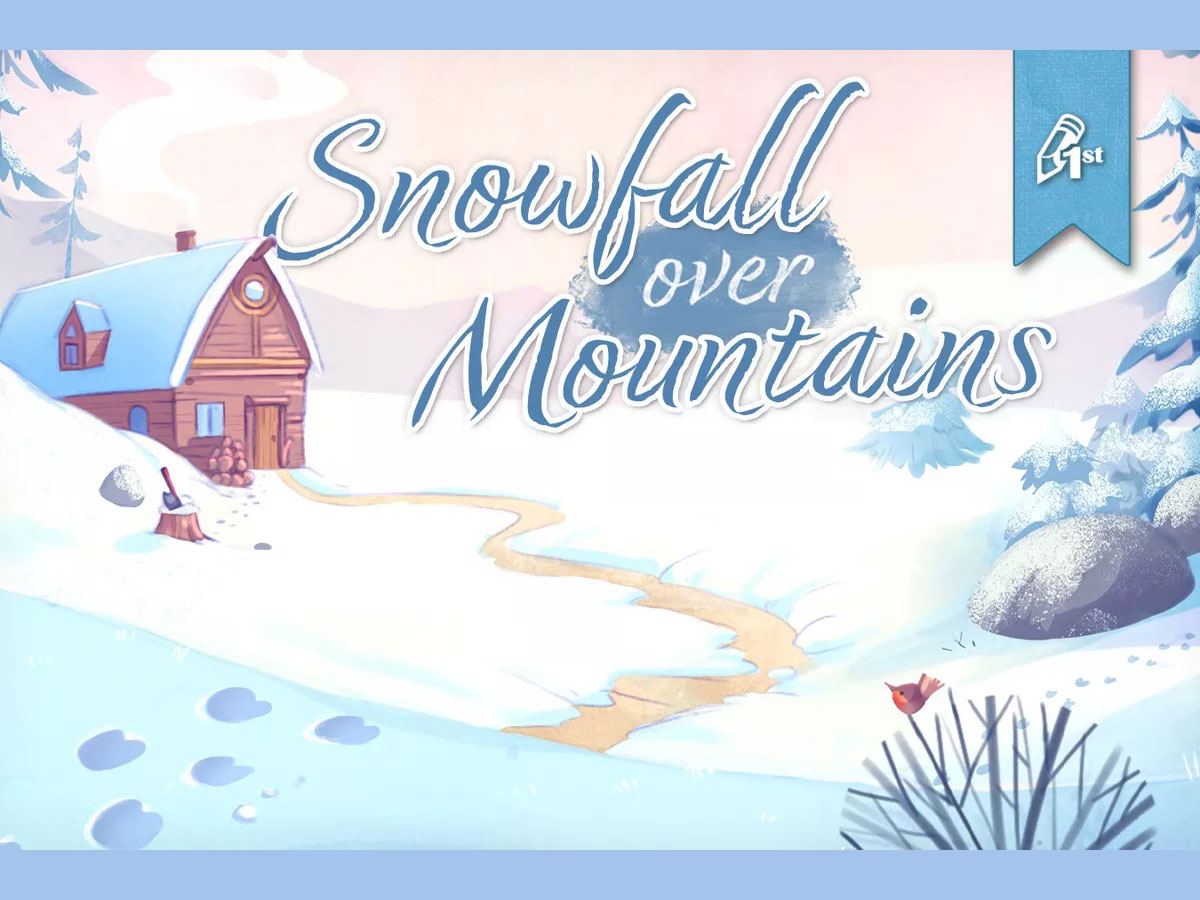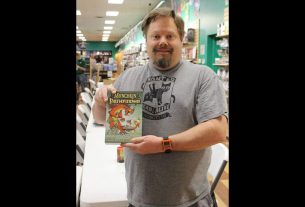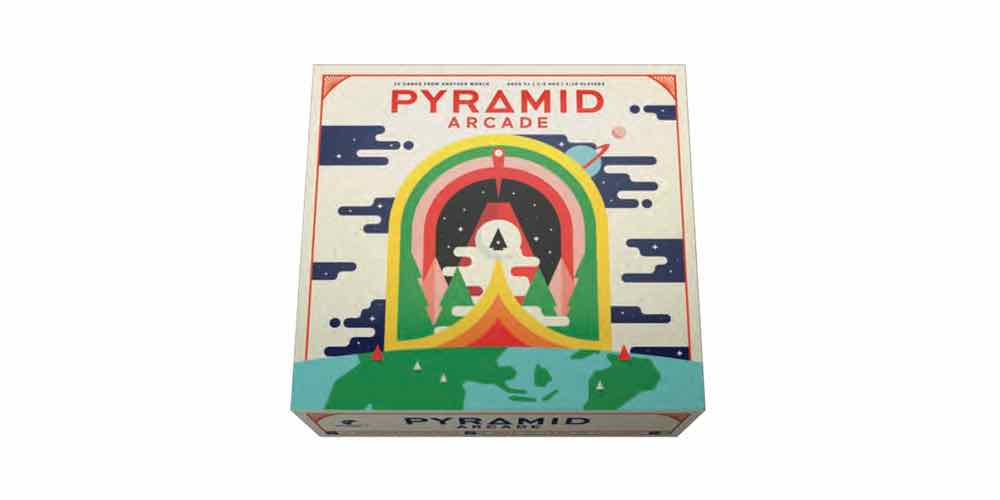Take a hike through the snow and look for animal tracks in this cozy solo game.
What Is Snowfall Over Mountains?
Snowfall Over Mountains is a solo tile-laying game for ages 14 and up, and it takes about 20 minutes to play. It’s currently seeking funding on Kickstarter, with a pledge level of $15 for a copy of the game. Snowfall Over Mountains is part of the Nature Games Trio, and the campaign also includes pledge tiers for Sunrise at the Studio (reviewed here) and a pocket edition of Floriferous (review of the full-size version here). Although the box says it’s for ages 14 and up, I think younger kids could learn it; since it’s a solo game, it could easily be adapted to be played together just as a cooperative puzzle.
Snowfall Over Mountains was designed by Scott & Melissa Caputo and published by Pencil First Games, with illustrations by Julia Körner.
New to Kickstarter? Check out our crowdfunding primer.

Snowfall Over Mountains Components
Note: My review is based on a prototype copy, so it is subject to change and may not reflect final component quality. Kickstarter backers will also receive the mini-expansion Another Winter’s Day which adds a set of scoring cards and a small 1×1 tile.
Here’s what comes in the box:
- Cabin tile
- 30 Snow tiles
- 15 Scoring cards
- 8 Tool cards
- Reference card

The tiles are small rectangles, with a 1×2 ratio so that each one consists of two squares. They have different features on them: a dirt path, animal tracks, frozen ponds, and plants. The animal tracks are tiny enough that, although there is a correct direction of travel for the animals, they mostly register as dotted lines so you don’t have to worry about the direction when connecting tiles.

The scoring and tool cards are small cards. That makes it possible for the whole game to be packed into a tiny box, a similar size to the other “pocket edition” games from Pencil First at about 3″x5″x1″. You can see in the photo above the way that the cardboard insert is designed so that the cards fit across two of the wells for the tiles. It’s a nice little pocket-sized package!
How to Play Snowfall Over Mountains
You can download a copy of the rulebook here.
The Goal
The goal of the game is to score the most points by placing the tiles to match the scoring criteria for each feature.

Setup
Place the cabin tile in the center of the play area with either side up. Shuffle the rest of the snow tiles and remove 4 of them without looking at them and put them back in the box. Make a supply with the rest of the tiles and draw 2 for your hand.
For each of the scoring card types, choose one at random so you have one card for each feature: bear, bush, pond, rabbit, and tree. Place these face-up nearby.
Shuffle the tool cards, draw 3 of them, and keep 2 of them. Return the rest to the box.
Gameplay
On your turn, you either place a tile or use a tool.

Tiles must be placed adjacent to existing tiles but can be oriented horizontally or vertically. You also don’t have to connect anything like paths and animal tracks, but it’s often to your advantage to do so depending on the scoring requirements. (You always want to connect the paths if possible back to the cabin because you’ll lose points otherwise.) After placing a tile, draw a new one from the supply.

To use a tool, just do what it says and flip the tool face-down. Tools are one-time-use and will award you a point each if you don’t use them by the end of the game.
Game End
The game ends when all the tiles have been placed.
Each of the features has a scoring criteria, often comparing things to what is adjacent to them. (Note that “adjacent” also includes things that are on the same square, so a rabbit track passing through the same square as a bush would still count that bush as “adjacent.”)
For instance, your longest bear track may score points for each adjacent rabbit track, or for adjacent trees. Rabbits want to pass by bushes or ponds, or maybe have a bunch of short segments. Usually, you want to clump bushes together and separate trees from each other, but there are specific details about how that works. To score ponds, you may need to pair them up, or surround them with other tiles, or put different features near them.

Add up all of your scoring cards, plus 1 point per unused tool. For each path tile that doesn’t connect back to the cabin, you lose 3 points.
Compare your score to the table to see how you did, from “Lost Traveler” (fewer than 46 points) to “Master Trailblazer” (76 or more points).
Why You Should Play Snowfall Over Mountains
I don’t generally play a lot of solo games, but I do enjoy tile-laying games. One of the things I’ve always enjoyed about tile games (like Carcassonne, one of the games that got me into the hobby) is the way that the map builds out over the course of the game. I like watching the paths grow and the land fill out to make a big picture by the end. The other piece I enjoy is the puzzle of it—how do you match up the things that are supposed to connect? What do I need to pay attention to so I can score more points? These two aspects of tile-laying games are present whether you’re playing by yourself or with other players, so the main thing I’m missing in a solo game is the opportunity to interfere with (and be stymied by) other players.
Snowfall Over Mountains has a great setting for a solo game, though, because it’s about exploring a snow-covered landscape, and so playing by yourself can give you that feeling of tromping around in the snow when everything is a little more muted both visually and audibly. You walk past snow-covered trees, bushes sparkling with ice, and spot some animal tracks and wonder where they were going. It’s a cozy little jaunt, and then you can get back inside and warm up with some hot cocoa.

The puzzle aspect of Snowfall Over Mountains comes in the scoring cards. There are three of each card (4 if you include the mini-expansion), so each time you play you’ll have a different puzzle to solve, and the real challenge is always making those decisions about which criteria to sacrifice in favor of others. For instance, the scoring for trees generally wants them separated—either placing each tree in its own row or column or not having trees adjacent to each other. For the row/column cards, you also score 3 bonus points if every tree meets the criteria, so then that can become an important goal. But what if placing a tree in its own column means that you cut off your longest bear track? Or break the cluster of bushes that you were trying to build?
The one thing I’ve learned is that you really don’t want to disconnect your paths to the cabin—I gambled in one game (pictured earlier) because I figured I had plenty of time to connect back to the cabin… but eventually found that I had built it in a way that there were no tiles remaining that would fit the gap. Four tiles of path that didn’t connect cost me 12 points! It was enough to basically cancel out an entire scoring card, so it definitely wasn’t worth the sacrifice. Your cabin tile has three path exits from it, and there’s one more tile in the batch that includes a T-intersection, but generally speaking, if you cut off too many paths then you’ll find yourself without a way to connect back.
Sometimes the goals can work together—if you get the bears that want to be near rabbits, and rabbits that want to be next to bushes, and the bushes always want to be clumped anyway, then that’s some nice synergy… but that still requires making all of the tracks connect, and putting all those tiles near each other might ruin your trees and ponds scoring. I ended up with one situation where my rabbits wanted to be near bushes, but the big clump of bushes ended up on the opposite side of the map simply because of a few ponds I had tried to place together.
Snowfall Over Mountains is a nice, casual game with a puzzle feel. It’s short, so you can easily sit down and play a couple of times in a row, and the portability means you can just stick it in your pocket to take it somewhere (though you do need some table or floor space to play out all the tiles). If you enjoy tile-laying games and particularly if you play solo games, it’s worth checking out!
For more information or to make a pledge, visit the Nature Games Trio Kickstarter page!
Click here to see all our tabletop game reviews.
![]() To subscribe to GeekDad’s tabletop gaming coverage, please copy this link and add it to your RSS reader.
To subscribe to GeekDad’s tabletop gaming coverage, please copy this link and add it to your RSS reader.
Disclosure: GeekDad received a copy of this game for review purposes.






